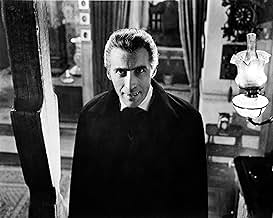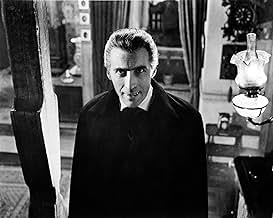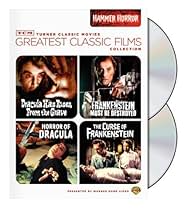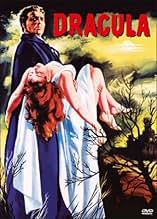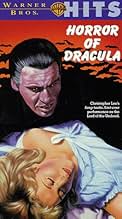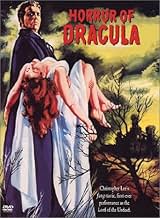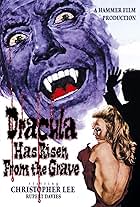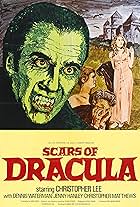When Jonathan Harker rouses the ire of Count Dracula for accepting a job at the vampire's castle under false pretenses, his friend Dr. Van Helsing pursues the predatory villain.When Jonathan Harker rouses the ire of Count Dracula for accepting a job at the vampire's castle under false pretenses, his friend Dr. Van Helsing pursues the predatory villain.When Jonathan Harker rouses the ire of Count Dracula for accepting a job at the vampire's castle under false pretenses, his friend Dr. Van Helsing pursues the predatory villain.
- Awards
- 1 win & 2 nominations
Janina Faye
- Tania
- (as Janine Faye)
Stedwell Fulcher
- Coach Passenger
- (uncredited)
- Director
- Writers
- All cast & crew
- Production, box office & more at IMDbPro
Storyline
Did you know
- TriviaIn 2007, this movie was selected for preservation by the BFI, but it wasn't until 2011 that an extended print, including a longer version of the disintegration sequence, was discovered at the National Film center in Tokyo.
- GoofsThe coffin Dracula uses in the undertaker's cellar has a large cross on the lid. Dracula could not touch that lid to get into the coffin.
- Quotes
Doctor Van Helsing: What are you afraid of?
Landlord: I don't understand you.
Doctor Van Helsing: Why all these garlic flowers? And over the window? And up here? They're not for decoration, are they?
- Alternate versionsThe film was cut for its original cinema release by the BBFC in 1958 to remove shots of blood during Lucy's staking and to reduce the final disintegration of Dracula. For later UK video and DVD releases the U.S print (titled "Horror Of Dracula") was used as this restored the staking scene in full, although the climactic disintegration remained edited (and may no longer survive). In May 2007 a new BFI 'restored' print was premiered in Cannes which includes the staking and restores the original title of "Dracula" to the opening titles.
- ConnectionsEdited into Dracula: Prince of Darkness (1966)
Featured review
As you can see by my rating, I like this film and think it's a good one. But the main thrust of my comments here will be to convey my personal opinion that, while I enjoy it for what it is, I do think it's also overpraised by many horror fans worldwide who seem to elevate it to iconic status, above and beyond all others of its ilk. "Horror of Dracula" is indeed a rousing vampire film, and a notable offering to feature the legendary character of Count Dracula. It is probably the first quintessential film I'd recommend to see if you're new to Hammer Horror; but when considered as the "definitive" be-all and end-all representation of Bram Stoker's immortal horror tale, it falls short.
In this obviously expedient version, the British Hammer studio tried to utilize a tight budget to full effect, and in the process attempted to present modern audiences with a completely different type of Dracula than they were accustomed to in Bela Lugosi's previous performance. So it is that "Horror of Dracula" tries to make up for having little money by spicing up the proceedings with a strong dose of fangs, hisses, blood, and a very speedy pacing, in what was probably an effort to distract from the cheapness as well as "improve" upon the more lethargic movement of the 1931 Tod Browning classic. And guess what? For many people, it worked! Audiences lapped up this approach, and the movie was a great hit both then and now. For many today, Christopher Lee has replaced Bela Lugosi as the true embodiment of Count Dracula for all time. Speaking for myself, I will always prefer Lugosi's rendering of the role, but Lee comes in at second place.
The story in "Horror of Dracula" is pretty basic, with Dracula staking a claim on victims, and then the great vampire hunter Van Helsing (expertly played by Peter Cushing) arriving to challenge his bloody rampage and hopefully save the day. As with just about any cinematic revision, some specific changes were made. And I've always felt they hampered the movie from becoming the truly "great" masterpiece which so many inexplicably believe it is:
1.) In this version, Jonathan Harker arrives at Castle Dracula (actually, with the meager budget it looks more like a cozy little cottage) fully aware of who and what Dracula is, but with the intention of posing as the vampire's librarian before actually destroying him. He also arrives on a bright and sunny afternoon (probably due to insufficient cash flow for night filming) which I feel ruins a good chance for chills and shudders.
2.)I also don't like that the voyage to England is gone.
3.) The character of Renfield has been completely written out. Now, in all fairness there were liberties taken in Browning's "Dracula" too, of course, but those worked for me (such as Renfield being the one to visit Drac and then being turned into his slave).
4.) Dracula's lack of any good dialogue. Bela Lugosi has more juicy dialogue in the 1931 film than Christopher Lee gets to speak in all of his many Hammer Dracula films combined! Aside from Lee's talk about there being "a great many volumes to be indexed" what else does he have to say? In the Lugosi film there are so many: "Listen to them - children of the night ... what music they make!" "I never drink --- wine..." "To die, to be really dead, that must be glorious!" "There are far worse things awaiting man -- than death..." "For one who has not lived even a single lifetime, you are a wise man, Van Helsing.."
5.) Though I do like Chris Lee as Dracula, my preference for his look and style comes more in later films. He's just too young in "Horror of Dracula" (he was only 36 at the time) and he relies way too much on just showing his teeth and hissing, and springing over tables like some acrobat. I'll take the deliberately slow, creepy and otherworldly strange creature as played by Bela Lugosi easily.
6.) The loud and deafening score by James Bernard is sometimes way overblown for a picture like this. Some of it is deliciously ominous and works perfectly (like in an early scene where a vampire woman eyes Harker's throat with a compulsion to bite) but the over-blasting of horns and trumpets are enough to wake the dead.
7.) The lack of supernatural abilities by Dracula is a tragic mistake. He doesn't change into bats or wolves, for instance. And not only doesn't he do these things in this but the Jimmy Sangster script even has the nerve to go out of its way to claim those old tales are "common fallacy"!
The final result is a good, solid, entertaining vampire movie that is not really "Dracula". In closing, I can't and won't take anything away from Peter Cushing. He's marvelous. And the final sequence where he meets up with Dracula for the grand finale is admittedly one of the highlights in all of cinematic horror. *** out of ****
In this obviously expedient version, the British Hammer studio tried to utilize a tight budget to full effect, and in the process attempted to present modern audiences with a completely different type of Dracula than they were accustomed to in Bela Lugosi's previous performance. So it is that "Horror of Dracula" tries to make up for having little money by spicing up the proceedings with a strong dose of fangs, hisses, blood, and a very speedy pacing, in what was probably an effort to distract from the cheapness as well as "improve" upon the more lethargic movement of the 1931 Tod Browning classic. And guess what? For many people, it worked! Audiences lapped up this approach, and the movie was a great hit both then and now. For many today, Christopher Lee has replaced Bela Lugosi as the true embodiment of Count Dracula for all time. Speaking for myself, I will always prefer Lugosi's rendering of the role, but Lee comes in at second place.
The story in "Horror of Dracula" is pretty basic, with Dracula staking a claim on victims, and then the great vampire hunter Van Helsing (expertly played by Peter Cushing) arriving to challenge his bloody rampage and hopefully save the day. As with just about any cinematic revision, some specific changes were made. And I've always felt they hampered the movie from becoming the truly "great" masterpiece which so many inexplicably believe it is:
1.) In this version, Jonathan Harker arrives at Castle Dracula (actually, with the meager budget it looks more like a cozy little cottage) fully aware of who and what Dracula is, but with the intention of posing as the vampire's librarian before actually destroying him. He also arrives on a bright and sunny afternoon (probably due to insufficient cash flow for night filming) which I feel ruins a good chance for chills and shudders.
2.)I also don't like that the voyage to England is gone.
3.) The character of Renfield has been completely written out. Now, in all fairness there were liberties taken in Browning's "Dracula" too, of course, but those worked for me (such as Renfield being the one to visit Drac and then being turned into his slave).
4.) Dracula's lack of any good dialogue. Bela Lugosi has more juicy dialogue in the 1931 film than Christopher Lee gets to speak in all of his many Hammer Dracula films combined! Aside from Lee's talk about there being "a great many volumes to be indexed" what else does he have to say? In the Lugosi film there are so many: "Listen to them - children of the night ... what music they make!" "I never drink --- wine..." "To die, to be really dead, that must be glorious!" "There are far worse things awaiting man -- than death..." "For one who has not lived even a single lifetime, you are a wise man, Van Helsing.."
5.) Though I do like Chris Lee as Dracula, my preference for his look and style comes more in later films. He's just too young in "Horror of Dracula" (he was only 36 at the time) and he relies way too much on just showing his teeth and hissing, and springing over tables like some acrobat. I'll take the deliberately slow, creepy and otherworldly strange creature as played by Bela Lugosi easily.
6.) The loud and deafening score by James Bernard is sometimes way overblown for a picture like this. Some of it is deliciously ominous and works perfectly (like in an early scene where a vampire woman eyes Harker's throat with a compulsion to bite) but the over-blasting of horns and trumpets are enough to wake the dead.
7.) The lack of supernatural abilities by Dracula is a tragic mistake. He doesn't change into bats or wolves, for instance. And not only doesn't he do these things in this but the Jimmy Sangster script even has the nerve to go out of its way to claim those old tales are "common fallacy"!
The final result is a good, solid, entertaining vampire movie that is not really "Dracula". In closing, I can't and won't take anything away from Peter Cushing. He's marvelous. And the final sequence where he meets up with Dracula for the grand finale is admittedly one of the highlights in all of cinematic horror. *** out of ****
- JoeKarlosi
- Sep 5, 2006
- Permalink
Details
- Release date
- Country of origin
- Official site
- Language
- Also known as
- Drácula
- Filming locations
- Bray Studios, Down Place, Oakley Green, Berkshire, England, UK(Studio, uncredited)
- Production company
- See more company credits at IMDbPro
Box office
- Budget
- £81,000 (estimated)
- Runtime1 hour 22 minutes
Contribute to this page
Suggest an edit or add missing content



